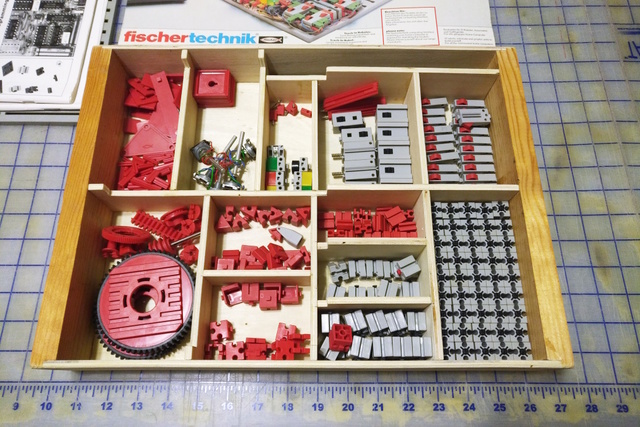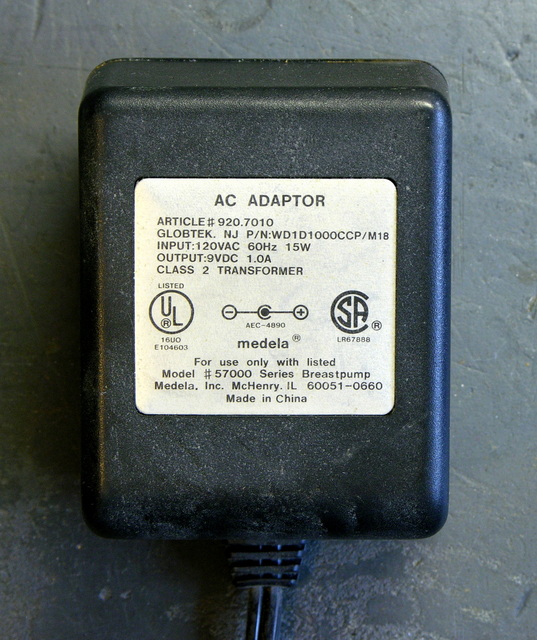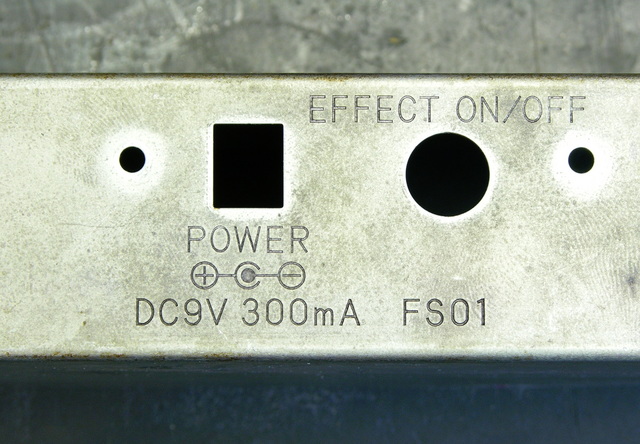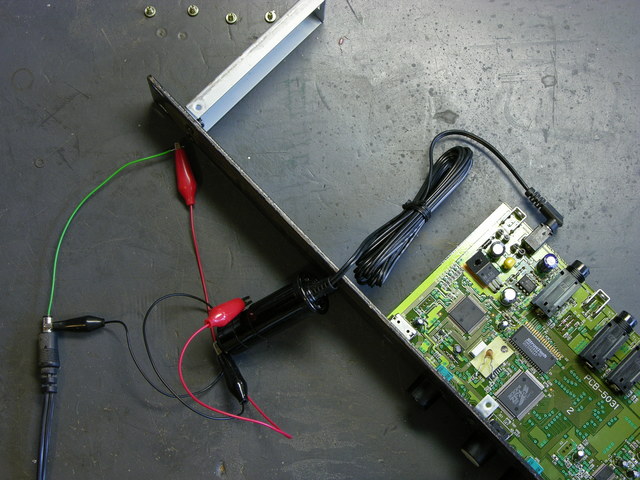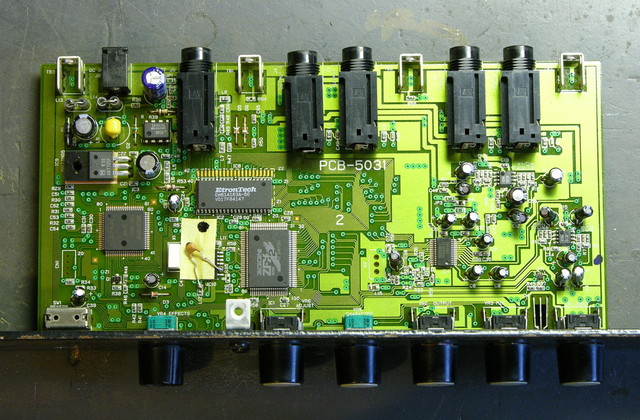My weekend’s entertainment was making this wooden tray to hold the parts from an Apple ][ era engineering construction toy.
Archive for the ‘Uncategorized’ Category
New Tray for Fischertechnik Computing Box
Monday, June 18th, 2018(Not) Fixing a Zoom Studio 1201 Effects Unit
Monday, November 3rd, 2008I recently bought an allegedly-broken rackmount audio effects processor on eBay, described by the seller thusly:
ZOOM STUDIO 1201
DIGITAL REVERB & MULTI EFFECTS
Powers On but no sound on output
It sounded like an interesting problem — maybe a bad jack or pot, or of course possibly a bad DSP or custom chip that I wouldn’t be able to fix — but worth $10 plus shipping to give it a shot. I was the only bidder; and after a long delay (one of the advertised features of the unit, but not one I expected from the seller) it was mine.
The first thing I noticed is that it did not, in fact, power on. The minimal instruction sheet says that the Peak LED goes green to indicate power and red to indicate peak / clipping; and mine remained off. So the unit did not, in any sense in which I’m familiar with the term, “power on.”
I checked the wall wart, thinking it might be faulty. It appears not to be the original power supply for this unit (see the verbiage at the bottom of the label — not, to my knowledge, synonymous with “audio effects processor”), but did deliver 9VDC.
Ah, but not the right 9VDC.
The replacement power supply had the wrong polarity. Thus I was even more puzzled as to in what sense this unit could have been considered to “power on,” unless the seller had the correct power supply while posting the unit for sale but delivered a different one.
I checked my wall wart bin but didn’t have a suitable replacement. So for testing, I used a few jumper wires and a passive auto power adapter with the same barrel connector to reverse the polarity:
And voila! Green power light. Maybe “powers on” means “with considerable effort.”
Having tested that it was worth the trouble — that the unit hadn’t been completely blown by reversed polarity — I cut and soldered the wall wart’s cable back together to deliver the correct polarity for this unit. (Mental note: I forgot to update the diagram on the wall wart — need to go back and do that.)
I took it to my synth and inserted it between the synth and powered speaker to test whether “powers on” now equated to “works completely,” and alas, it did not. The input trim pot works and impacts the output volume; the output volume control works and impacts the output volume; but no other controls have any effect. It’s as though I’m constantly getting a “dry” mix.
I tested the wet/dry pot in circuit, and it does vary resistance continuously over its range, so it doesn’t appear to be the problem. I tested the foot pedal effects override jack with both my meter and a spare plug, and it doesn’t appear to be faulty — and the instruction sheet says disabling effects with the foot switch will make the Peak light will go amber, which isn’t happening. I touched up the solder joints on one of the effect selector switches, and no difference. Still the “dry” sound coming straight through to the output.
Particularly puzzling to me is that the Reverb Effects selector (which is a pot with detents rather than a position encoder — evidently an A/D input was cheaper than four digital inputs) causes a brief dropout of output as it’s rotated between positions; so something appears to be talking through the digital guts of the beast. But no matter the setting, I still get the dry output.
I should note that the effects bank selector switch, although physically broken, is still electrically functional — moving it to the different positions with a small screwdriver does provide continuity among different sets of contacts on the back.
I realize now that I’ve only been testing the left channel so far, as it doubles as the mono channel. I should try testing the right channel in case something in the signal path is only broken on the left.
Anyway, at the moment I differ slightly with the seller: powers on when you hook it up right, original sound on output, but no effects.
Shhhhhh! (Quieter Fan for My Switch)
Monday, July 16th, 2007The fan in the network switch in my home office is too loud. It’s the loudest thing in the whole room — louder than my newish and very quiet Dell PC. (Fedora, installed before ever booting the preinstalled XP Home, in case you wondered.)
I’d rather not have a switch there at all, but the DSL comes in on the ground floor (where my office is), I’ve tucked my server down in the basement, and I haven’t installed structured cabling yet. (The house is a hundred years old and the crawlspace is . . . interesting.) I need more connections going back and forth than I have cables, which means using a switch.
The Cisco switch I was using had only 100M ports, but my workstation and server both have integrated gig ethernet, so I was looking to upgrade the switch anyway.
I recently bought an old Linksys GigaSwitch EG0008 on eBay. It’s a 1U rack case with only eight gig ports on it — pretty much an antiquated beast. I was hoping it’d use passive cooling or at least have a quieter fan than my Cisco 1924.(*) Boy, was I wrong.
The Linksys has three fans, each loud. Two are in the center of the back, and there’s a separate one by the power supply. I took a little time yesterday to try to quiet it down.
Before
I used my sound level meter (an older version of this Radio Shack meter) to measure how loud each fan was. This was a very informal test intended just to give me a general idea; and due to the range of the meter, I measured from about 10cm away instead of the standard 1m.
I unplugged two fans at a time so I could test each fan individually. The small fan in the corner was the loudest, at about 58dB. Each of the two larger fans in the back registered about 57dB. With all of them running, I got about 62dB total.
Fan Changes
The first step was simply unplugging the two larger fans in the back. In an unventilated wiring closet, or stacked in a rack with other hot equipment, I’d want all the forced air I could get through this thing. But sitting in my office on a small stand under the base of my LCD monitor, it’s not going to get very warm. It probably doesn’t need any fans there, and one should certainly be enough.
With only the small fan plugged it, the volume dropped to slightly louder than my Cisco. Not good enough.
The small fan sounded a little rough to me, so I peeled back the sticker and added a drop of oil to its axle. It smoothed out a bit, but still not good enough.
I had another 40mm fan on hand that I bought last year from All Electronics, so I soldered a connector onto it and hooked it up to the power. Sitting out in the open, I measured it around 54dB, so it seemed to be an improvement.
The original fan wasn’t mounted with screws or bolts, but rather by snapping into position. With the replacement fan being so much slimmer, it no longer fit the slot. Since this isn’t for a ruggedized mobile application where things bounce around a lot, I just stuck it in place with hot glue.
Once in place, it measured about 58dB — the same as the original fan. Grrr.
Vent Holes
I noticed two differences in the sound of the replacement fan between when it was sitting in the open and when it was mounted in the case. The case acted as a sounding board to amplify the fan’s noise; and there was considerable wind noise when the fan was in position. I didn’t really have room to isolate the fan from the case with rubber strips, but I did tackle the wind noise.
The ventilation holes behind the fan were not exactly what I’d call generously sized. I used my stepped drill bit to enlarge all of the holes that were in line with the fan’s blades.
After reinstalling the new fan, the overall noise level dropped to 54dB, a slight improvement over the first installation of the new fan and a considerable improvement over the original equipment.
I reassembled the switch and swapped it into service in my office, and it seems to be about as loud as the Cisco was. Interestingly, the pitch of the noise is a little different, so I notice it each time I step in the doorway. I’ll get used to it soon enough.
Closing Thoughts
In retrospect, since both the original and replacement 40mm fans measured about 58dB when mounted in the case before enlarging the vent holes, I could probably put the original fan back in and have approximately the same sound level improvement.
I’d like to find a quieter fan, though. I know there’s a whole market for PC case mods with really, really quiet fans. I’ll ask around and see whether anyone I know has a tested source. So rather than go back in to reinstall the original fan, I’ll hold out for a yet-quieter replacement.
Footnote
* Yes, I know the Cisco 1924 is a 10M switch. My 1924s have two 100M ports commonly used as uplinks; so at each end, one of the ports is the uplink and the other connects to the fast computer. The DSL firewall only gets a 10M port, which is faster than its WAN side anyway.
Farewell to Slim
Monday, June 11th, 2007My friend Rolland “Slim” Cummings passed away of a heart attack this afternoon. He was the director of Instructional Media at Pittsburg State University. His wife Maeve is a professor in the PSU College of Business and the coauthor of a best-selling MIS textbook for which I rewrote the networking chapter.
Slim built the video distribution network at PSU, including a video switcher of his own design and construction, to route TV channels and videotapes to individual classrooms. He was active in amateur radio and electronic design, and was a close friend of the late Jack Buffington and mentor to his son and my good friend, Cort. Slim was always the one to test every option or method, not settling for good enough, but insisting on finding the best.
He was also opinionated and bullheaded, and could hold a grudge for years. Long before I knew him, he and Maeve had an Apple Computer dealership. Something happened to sour that relationship; and much later, when Slim gave me a couple of sticks of surplus RAM, he said he wouldn’t have given them to me if he’d realized I was going to put them into a Mac. But he showed respect with equal intensity when he was treated fairly, as I saw time and time again when I worked with him at the university.
Slim was generous with his knowledge and his resources. He spent a lifetime collecting electronics supplies and surplus, and he was always ready to share them when they were needed. He slowed down several years ago and had started cleaning house and discarding old equipment, sending carloads of mostly junk home with me. My bench power supply, my function generator, my gigantic bare copper PC board, and the panel meter I used in my battery meter project are just a few of many supplies Slim gave me.
I last saw Slim just over two weeks ago, on a rare trip back to Pittsburg for an unrelated conference at the university. I joined Cort for a visit up to Instructional Media, and we helped Slim haul equipment to the pile for the annual university surplus auction (and ourselves left with another trunkload). Just this weekend, I emailed Slim to ask about a giant heatsink I’d given him a few years ago as a bit of a joke, and he said I was welcome to it; was I going to be back that way or should he ship it?
I wish I’d been able to go back to pick it up from him myself.
Meta: Upgraded WordPress
Friday, June 30th, 2006I’ve upgraded my WordPress blogging software from version 1.5 to 2.0.3. I’m seeing a lot of changes behind the scenes, but not much in the up-front display. If you notice anything that doesn’t seem to be working right, just add a comment to this post and I’ll look into it.
I’m trying to find a way to remove all of the sub-pages (Roomba, PowerBook, etc.) from the sidebar, so they don’t clutter up every view but you can still access them from their master index page. It looks like there may be a way to do it with page templates and customizing the theme, but GAAAAHH!!! Surely someone else has done it by now???
Follow-up:
I’ve found Daniel Schindler’s Exclude Pages plugin, which lets me enter the IDs of pages to exclude from the list. It’s clumsy and I’d much prefer something that has a flag on the page’s own editing screen–but it works, and that’s enough for now.
